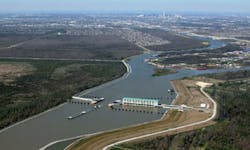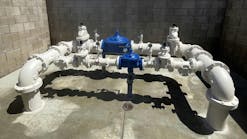| The GIWW-West Closure Complex includes the largest drainage pumping station in the U.S. |
The U.S. Army Corps of Engineers was charged with a significant role in improving the future safety of the region. Congress appropriated $14.45 billion for the Corps' Hurricane and Storm Damage Risk Reduction System (HSDRRS) for Southeast Louisiana. The $1-billion Gulf Intercoastal Waterway – West Closure Complex (GIWW-WCC) is a critical component of this system.
The complex is designed to reduce storm risk for residences and businesses in three parishes on the west bank of the Mississippi River: Orleans, Jefferson and Plaquemines. Specifically, the project reduces the risk associated with a 100-year storm surge -- an event that has a 1-percent chance of occurring in any given year.
Challenge
"The GIWW-WCC project is one of the New Orleans District's largest, most complex hurricane and storm damage risk reduction projects," said Kevin Wagner, senior project manager, U.S. Army Corps of Engineers. "It involves nearly every aspect of the Corps' typical civil works mission."
The project encompasses levees, floodwalls, water control structures, a navigable floodgate, foreshore protection, dredging, beneficial use of dredged material, and environmental stewardship. It also includes the largest drainage pumping station in the country.
When the floodgate closes during a storm, the pumping station must evacuate rainwater that is pumped to it from other stations in the system. To handle a 100-year storm surge, original specifications for the station called for eleven 5,500 HP pumps capable of moving nearly 20,000 cubic feet of water per second.
The station also required a reliable and secure supervisory control and data acquisition (SCADA) system to provide diesel fuel and systems control for the pumps as well as remote, hurricane-protected monitoring.
In addition to technical challenges, contractors charged with the construction and installation of the pumping station faced other pressure: Since the Gulf Intercoastal Waterway is a federal navigation channel with heavy commercial traffic, it had to remain fully functional throughout all phases of the project. Further, the complex is near a protected wetland, which could not be compromised.
"Public safety is the Corps' number-one priority," said Wagner. "Therefore, we imposed an expedited construction schedule for all project features." Construction on the complex began in August 2009 and was targeted for completion by the end of 2013.
Solution
Prime Controls, a Rockwell Automation Solution Partner, received the contract for the pumping station's SCADA system. ARCADIS, a consultancy, design, engineering, and management firm, designed the solution.
"We had worked with ARCADIS and the Army Corps of Engineers to upgrade more than 20 other pumping stations throughout the Greater New Orleans area," said Gary McNiel, senior vice president, Prime Controls. "During those projects, we established Rockwell Automation as the controls provider of choice."
For the new GIWW-WCC project, Prime Controls installed a SCADA system based on the Rockwell Automation Integrated Architecture® platform. The redundant system includes Allen-Bradley® ControlLogix® programmable automation controllers and FactoryTalk® View SE visualization software, running on a redundant Ethernet ring network. Allen-Bradley CompactLogix™ controllers are also integrated into the solution to manage the fuel delivery and return system's extensive distributed I/O.
"The critical nature of the pump stations requires redundancy in every system," said McNiel. "Hot standby dual ControlLogix controllers -- plus hot standby SCADA servers -- supply the necessary backup," he explained. "We chose the FactoryTalk View application because it provides not only the monitoring and control graphic capability but also the required reporting and data logging."
The SCADA solution supplies all information needed to operate the pumping stations, including pump, engine and electrical-generator data, plus water-level data from the intake and discharge areas. The system also monitors the pump's diesel-fuel levels and incorporates weather information and closed-circuit television (CCTV) surveillance for security purposes.
In addition, the same SCADA system controls the sector gates, which regulate the water level across the navigational waterway.
The system is monitored through a user-friendly Allen-Bradley PanelView™ Plus interface from an environmentally controlled safe house within the pump station. The solution was built to easily migrate to off-site remote monitoring at a future date.
The SCADA solution was fully operational in July 2012.
"Meeting the expedited schedule was a joint effort," said McNiel. "We had excellent support from Rockwell Automation's New Orleans sales office, as well as the local Allen-Bradley authorized distributor, The Reynolds Company."
Results
When Hurricane Isaac hit the Southeastern Louisiana coast on Aug. 28, 2012, the new SCADA solution and entire West Closure Complex underwent an unanticipated -- and high-stakes -- test.
Although Hurricane Isaac was a Category-1 storm based on wind velocity, the storm surge was significant. A slow-moving storm with a broad wind field, Isaac caused storm surges more than 12 feet above normal tide levels. In some parts of Southeast Louisiana, water levels on the ground reached 17 feet.
"Unfortunately, Hurricane Isaac provided a very good test for the new system," McNiel said. "Thankfully, the system withstood the test."
The system performed as designed and successfully protected much of the Greater New Orleans area from the surge.
"It took a multi-disciplinary, diverse Project Delivery Team, including multiple U.S. Army Corps of Engineers' districts within the Mississippi Valley Division, plus many contractors and subcontractors, to successfully design and construct the GIWW-WCC," said Wagner.
"We are pleased with the work of the team," said McNiel. "We hope to install Rockwell Automation solutions in upcoming projects."
Note: The results mentioned above are specific to U.S. Army Corps of Engineers' use of Rockwell Automation products and services in conjunction with other products. Specific results may vary for other customers.
More WaterWorld Current Issue Articles
More WaterWorld Archives Issue Articles



